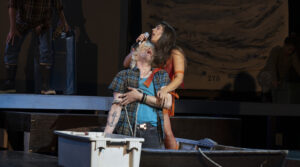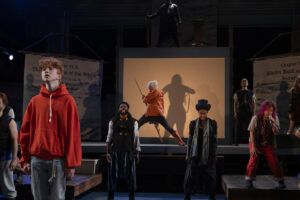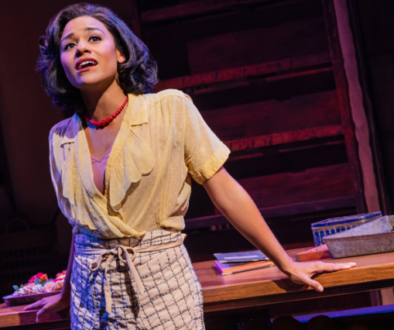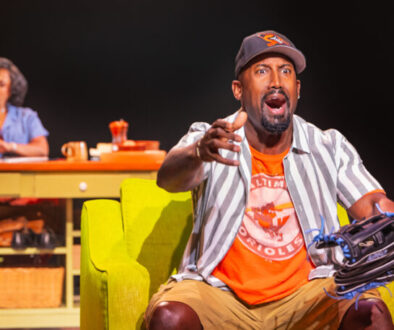By SCOTTY BENNETT
One of the most famous opening lines of a novel is “Call me Ishmael.” It is from Herman Melville’s Moby Dick, a book many people are aware of but have never read. It is not the actual opening line, as two sections of prologue set the stage for what is to follow.

The actual opening is “The pale Usher—threadbare in coat, heart, body, and brain; I see him now,” which introduces two sections on whales and whaling, with the first being an etymological definition of whales and the second containing a multitude of excerpts about whales and the view of them over the years.
The prologue is a more powerful opening for a complex story of obsession, revenge, spirituality, interpersonal human relations, and the relationships between humans and nature than the simple line “Call me Ishmael.” However, that line is powerful in and of itself. “Moby Dick or The Whale” is considered a masterpiece of American literature.
The Moby Dick Blues, with book and lyrics by Michael Gorman and music and direction by Joe John Battista, is a story attempting to make a connection between the classic Melville novel and the contemporary opiate epidemic in New Bedford, Massachusetts, and other New England fishing communities. While a laudable effort, it misses the mark.

The character Moby Dick was not a metaphor for opium in the original story. Even though Ahab’s pursuit of the white whale may appear to be an addiction to some, it is really an obsession. The whale Moby Dick is an example of humanity’s limited understanding of the natural world and the tendency to anthropomorphize the actions of creatures they don’t understand.
The production is billed as a “working-class opera for our planet…” but with a limited libretto and a muddled book, it is not an opera. It can only be marginally considered a musical. While some of the songs are moving, the entire score fails to support the emotional arc of the story effectively. In the final analysis, the attempt to link the opiate epidemic in New England fishing communities to Melville’s novel doesn’t work, mainly because the whale Moby Dick is not a metaphor for opium addiction.
The show is composed of three major elements; the fictional world of Moby Dick, the past of the New England fishing communities, and the present time of those communities. These dramatic containers intersect and overlap without clarity. Even in reading the script, understanding the reason for some of the interactions is confusing. In the staging, it is not clear which period is being illustrated or how the events of one section are related to the moment at hand or to the actions that preceded it.

The large cast makes a superb effort to make sense of what is happening, but the lack of a clear narrative thread makes some of the scenes little more than non sequiturs. In several scenes, characters representing the past, present, and the fictional world of Moby Dick interact, attempting to illustrate the connections between the actions of those periods. The script, at times, provides a narrative direction for some of these actions. Still, it is not something that is communicated to the audience.
The ensemble was mostly solid in their embodiment of the various characters. The same cannot be said for the vocals, which are only okay in some instances. The spoken lyrics did not work well, coming across more as straight dialogue rather than a rhythmic recitation.
The cast ensemble is made up of Daniel Yaiullo (Ishmael), Gabbi Beauvais (Heroin), Alex Notkin (Ahab), Teddy Lytle (Robby Jr.), Jim O’Brien (Robby Sr.), Andrew Ryan Perry (Ray), Sarah MacDonnell (Therese/The Hungry Ghost), Shuhei Kinoshita (Tashtego), Sam Rothermel (Billie), Kristy Beauvais (Billie The Crab), Jessica Phoenix, (Phillipa/”Pip”), CREDLE (Fedallah), Sevin Ceviker (The White Whale), MoonSky (Phantom #1), Tiera Lopper (Young Billie), Christian Neal (Phantom 2), Henry MacDowell (Young Robby), Erick Alonso (Fisherman/Phantom).
While most of the performances are well-executed, one performer stands out: Daniel Yaiullo as Ishmael. He operates as narrator and guide, fully embodying what I consider to be the character of Ishmael in this play. He provides gravitas to both the quest for Moby Dick and the emotional struggles of the fisherman of New Bedford.

Christopher Akerlind’s lighting design effectively supports the action on stage. Costume Designer Angela Wendt has done a superb job in creating costumes that are true to the periods and environments depicted. The Choreographer, Sevin Ceviker, has not only orchestrated the overall movement of the cast and set elements but also performs as the White Whale in various scenes. The Music Direction by Kavi Gasper works well within the limitations of the score. The opening vocal number, “The Moby Dick Blues,” is solidly sung by Gabbi Beauvais as the character Heroin.
The set design gives a reasonable depiction of waterfront docks in a fishing community, including two prop boats. It is not clear who is responsible for the overall design but Gregory De La Haba and Andrew White are listed in the program as Collaborating Artists in conjunction with elements of the set design. I assume they were instrumental in how the set was articulated and given the venue, they made a believable scenic depiction. The show also includes projections that play a supporting role in some of the scenes and are effectively used.
The Moby Dick Blues (2 hours and 20 minutes including intermission) ran at the Ellen Stewart Theater of LaMaMa Experimental Theatre Club, 66 East 4th Street in New York, from June 7 22, 2025. through June 22, 2025)






Sybil Sloane
June 30, 2025 @ 1:49 pm
I saw this production twice (yes, it was that good!), and this “reviewer” clearly does not get the metaphor behind the production, nor does he understand that while Moby Dick was not a metaphor for opium in the original story, it IS here. This is not a literal retelling of Moby Dick, and the reviewer is clearly confused, disappointed, and limited in his analysis. There is so much more here than this reviewer could see or communicate! In the future, this reviewer might want to stick to more conventional theater, or, perhaps give up reviewing completely. This production was obviously way over his head!
Scotty Bennett
June 30, 2025 @ 7:07 pm
Dear Ms. Sloane: Thank you for your response. What do you think are the reasons the playwright used Melville’s tale as the framework for his story if not to imply a connection between Ahab’s obsession with Moby Dick and Therese, Robbie Jr, and Billie’s pursuit of the white whale of heroin? The following is from the script:
AHAB’S VOICE: It was a white whale … a white whale, I say. She stole from me.
AHAB’S VOICE: (softly) It was a white whale.
ISHMAEL: I do believe “thou surrenderest to a hypo,” Captain Ahab.
If you read some of the interviews with the playwright, you will discover that the playwright considered Ahab’s pursuit of the White Whale to be about addiction. The play repeatedly attempts to make connections with the Melville tale. I never implied that it was a literal retelling of Moby Dick, but rather an attempt to thematically connect the story of New Bedford’s fishing community to some of the key characters in that story and relate it to the opioid epidemic.